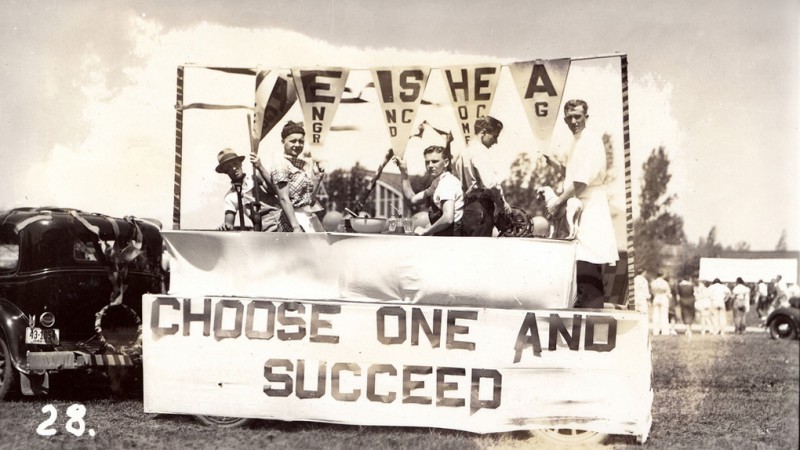Editorial: Despite risks of “unofficial” Veishea, the celebration is still key for Iowa State
Photo courtesy of Iowa State University Library, University Archives/Flickr
Participants celebrate in the 1936 Veishea. Over the past 90 years, the festival has evolved in size and stature but has also gained notoriety from the off-campus parties and riots, which have resulted in deaths, damage and unwanted attention.
May 31, 2012
Very soon during this year’s Veishea week, after the death of a young man who was not an ISU student, another round of questioning whether Veishea should continue was touched off. Most notably, the Ames Tribune printed a series of articles that examine such aspects of Veishea as its economic impacts, safety and policing, the responsibility for the “official” Veishea put on by the university and the “unofficial” Veishea that is made up of parties among students and their guests, and whether it can be fixed, all following an editorial that asked, “Is it time for ISU to end Veishea?”
Even though it is well-considered and well-intentioned, such criticism fails to account for the fact that the problems presented by Veishea are larger than a giant, weeklong college party. They are larger than alcohol use by college students. They are larger than a massive influx of out-of-town visitors to Ames, and are larger than rowdy participants getting out of hand in their overindulgences. The problem of Veishea is wide and can even be exemplified by the way we talk about it. Over the years, the Daily has varied back and forth between capitalizing only the first letter in ‘Veishea’ and making use of the word as its actual acronym, ‘VEISHEA.’
Instead of a party, Veishea is a celebration and showcase of everything that makes Iowa State Iowa State. Unfortunately, many of us — students, faculty and Ames residents alike — have forgotten that the letters that spell the word ‘Veishea’ are supposed to stand for something. The acronym may be defunct now, Iowa State no longer being made of the Colleges of Veterinary Medicine, Engineering, Industrial Science, Home Economics and Agriculture, but Iowa State still exists.
Some features and aspects of Iowa State, believe it or not, make it unique from other public research land-grant universities. We even have traditions that maintain those distinctions. Deciding to come to Ames for Veishea is not a matter of asking, “Where else can I catch a buzz this weekend and maybe participate in a riot?” It is, rather, a matter of asking, “What is a more appropriate place to celebrate what is now a 154-year history of Iowa State that includes one of the most beautiful campuses in the United States; developments in science and technology that include computing and atomic energy; the initiation of the Department of Agriculture’s Cooperative Extension Service that connects agricultural producers with the latest agricultural research; and any number of other particulars of Iowa State?”
Hazards to public order and personal safety that go with any exposure to others and the temptations of inebriation are heightened during Veishea as a matter of course. Most people, college students especially, will, given a halfway good excuse, drink more than they should, act more rowdily than they should and generally neglect their civic duty to preserve a safe, orderly environment. It will, quite simply, get out of hand and morph from a celebration into a party.
Everyone involved in Veishea, from students to organizers and beyond, is to blame for its excesses. Certainly we do not seek to escape blame for Veishea’s collateral damage; but we do want to suggest that that is what the riots and deaths are: collateral damage. They do not happen because Veishea is also happening. Instead, Veishea is the catalyst for bringing to the surface the larger problems present within our society: that people would rather do what anybody else could do anywhere else instead of carving out something unique, or that they would rather stupidly indulge in reckless intoxication. With Veishea, as with almost every other troubled event, the problems presented by only a few individuals give the rest of us, and the whole celebration, a bad name.
As we look for solutions to such problems, we too often look toward official institutions. Social ills cannot be resolved by city council decree or some legislative act, as laws do not change one’s morality and ethics. The casual, spontaneous, organic, hard-to-start and harder-to-stop institutions and customs of society are in a state of neglect; changing them does not happen overnight, but accepting that fact as futility is to resign to the way things are rather than subtly convincing people to be more responsible. Getting rid of the “official” Veishea is no solution to the “unofficial” Veishea that happens on the other side of Lincoln Way.

















